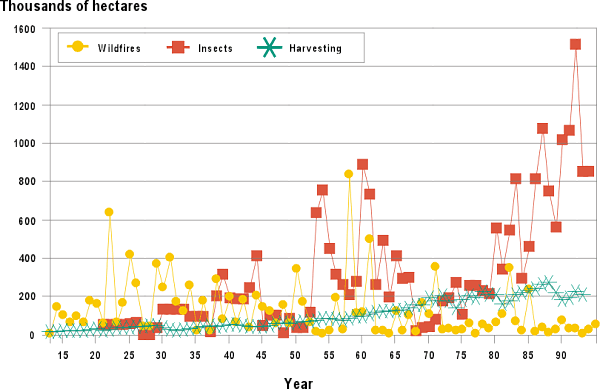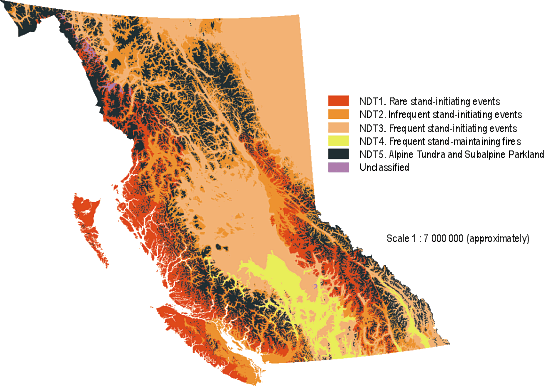1.8 Landscape level management
What can we do at the landscape level?
Assuming that species have evolved in habitats similar to today's natural ecosystems and may depend on the characteristics of those habitats, we can maintain biodiversity in managed forests by trying to maintain habitat patterns and successional stages that are similar to the historic variety of ecosystems in natural landscapes. This is prudent management, despite that we lack clear evidence of the landscape pattern requirements of most species.
This approach to forest management means developing long-term management plans that acknowledge the importance of historic patterns in the size and shape of forested patches, the age and species composition of natural ecosystems, and the connections between forested areas.
What else can be done?
At the landscape level, biodiversity across managed forest can be sustain by:
- Maintaining networks of representative and special habitats (A Forest Eco-system Network or Fen)
- Maintaining a range of forest ages outside the Fen
There are two types of disturbances processes within the coarse filter approach:
- Natural disturbance processes
- Stand level disturbance processes
a. Natural disturbance processes
All naturally occurring ecosystems in British Columbia have evolved, and are still evolving, under the influence of various disturbance forces. These are usually stand-initiating or stand-maintaining processes that include:
- Wildfire
- Windstorms
- Snow avalanches
- Landslides
- Flooding
- Insect outbreaks
- Disease
See Figure 3. Disturbance history of British Columbia's forests (left).
Stand-initiating disturbances are those processes that largely terminate the existing forest stand and initiate secondary succession in order to produce a new stand.
On a landscape scale (e.g., watershed size, usually between 10,000 and 100,000 ha), wildfires, and some epidemic level insect outbreaks are the major disturbance regimes that impact large areas and are usually considered stand initiating.
Small scale stand-maintaining disturbances serve to keep successional processes stable, and include the understorey surface fires that commonly occur in the Interior Douglas-fir and Ponderosa pine biogeoclimatic zones, and endemic windthrow in coastal areas.
In some situations, human induced disturbances such as prescribed fire can be used to mimic natural disturbance processes. For example, controlled understorey burning in the Ponderosa pine zone can be used to maintain or restore open canopy forests containing small meadows, thereby enhancing habitat quality for animals such as sharp-tailed grouse and badgers.
Often a variety of management practices are needed to respond to (and mimic) the different natural disturbance regimes under which ecosystems have evolved.
Therefore, for setting landscape level biodiversity objectives, five natural disturbance types (NDTs) are recognized as occurring in British Columbia.
See Figure 4. Distribution of NDTs across British Columbia (left).
These areas are characterized by different natural disturbance agents (mostly wildfires, windstorms, and to a lesser extent, insects and landslides), and are defined by groupings of biogeoclimatic zones, subzones, and/or variants that have similar disturbance regimes. Landscape unit biodiversity objectives and associated management practices are based on the natural disturbance types (and ecosystem processes) found in a particular landscape unit.
Further information on establishing landscape unit biodiversity and seral stage objectives for natural disturbance types is found in the Biodiversity Guidebook.
How do natural disturbances influences biodiversity?
Are there other natural disturbances influences? Wildfires, insect outbreaks, diseases, avalanches, windthrown trees, and other natural disturbances help shape forest structure and habitat patterns. These patterns range from small patches caused by the death of single trees to large tracks of large forests caused by extensive wildfires.
Forest management practices such as timber harvesting, fire suppression, range management also affect biodiversity by changes to:
- The structure and composition of individual stands or treatment units
- The distribution of treatment units through space and time
- Processes of predation, dispersal, and migration that sustain plant and animal communities
Although harvested ecosystems grow and change over time forest management practices can create habitats that quite different from those caused by natural disturbances. Managing biodiversity means recognizes those differences and trying to create managed stands that more closely resemble natural forests.
b. Stand level disturbance processes
Windthrow may affect large areas, but more usually impacts smaller, stand size areas (typically <100 ha). In some forests such as the wetter subzones of the Coastal Western Hemlock, this is a dominant natural disturbance force.
These sorts of disturbances affect forest succession by:
- Creating gaps ranging in size from single tree to <= 100 ha
- Promoting structural heterogeneity on a small scale
- Leaving important biological legacies of standing dead trees and dying trees, downed wood, and forest floor organic material





